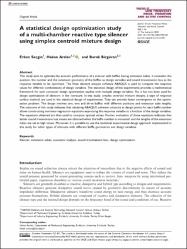| dc.contributor.author | Secgin, Erkan | |
| dc.contributor.author | Arslan, Hakan | |
| dc.contributor.author | Birgoren, Burak | |
| dc.date.accessioned | 2020-06-25T17:34:32Z | |
| dc.date.available | 2020-06-25T17:34:32Z | |
| dc.date.issued | 2021 | |
| dc.identifier.citation | Seçgin, E., Arslan, H., & Birgören, B. (2021). A statistical design optimization study of a multi-chamber reactive type silencer using simplex centroid mixture design. Journal of Low Frequency Noise Vibration and Active Control, 40(1), 623–638. | en_US |
| dc.identifier.issn | 1461-3484 | |
| dc.identifier.issn | 2048-4046 | |
| dc.identifier.uri | https://doi.org/10.1177/1461348419901227 | |
| dc.identifier.uri | https://hdl.handle.net/20.500.12587/2754 | |
| dc.description | Arslan, Hakan/0000-0002-2019-1882 | en_US |
| dc.description | WOS: 000509202000001 | en_US |
| dc.description.abstract | This study aims to optimize the acoustic performance of a silencer with baffles having extension tubes. It considers the position, the number and the extension geometry of the baffles as design variables and sound transmission loss as the response variable to be optimized. The finite element analysis software ABAQUS is used to compute the response values for different combinations of design variables. The statistical design of the experiments provides a mathematical framework for such computer design optimization studies with multiple design variables. Yet, it has not been used for design optimization of silencers in the literature. In this study, simplex centroid mixture designs, a type of response surface method, are used in the statistical design of experiments. They can provide faster convergence on the optimization problem. The design involves one, two and three baffles with different positions and extension tube lengths. The outcome of this study indicates that obtaining ABAQUS software solutions at design points for each baffle number allows constructing nonlinear regression equations expressing the response variable as a function of the design variables. The equations obtained are then used to compute optimal values. Further evaluation of these equations indicates that better sound transmission loss values are obtained when the baffle number is increased, and the lengths of the extension tubes are set at high values. Moreover, it is possible to use the statistical experimental design approach implemented in this study for other types of silencers with different baffle geometries and design variables. | en_US |
| dc.language.iso | eng | en_US |
| dc.publisher | Sage Publications Ltd | en_US |
| dc.relation.isversionof | 10.1177/1461348419901227 | en_US |
| dc.rights | info:eu-repo/semantics/openAccess | en_US |
| dc.subject | Silencer | en_US |
| dc.subject | extension tubes | en_US |
| dc.subject | acoustical analysis | en_US |
| dc.subject | sound transmission loss | en_US |
| dc.subject | design optimization | en_US |
| dc.title | A statistical design optimization study of a multi-chamber reactive type silencer using simplex centroid mixture design | en_US |
| dc.type | article | en_US |
| dc.contributor.department | Kırıkkale Üniversitesi | en_US |
| dc.relation.journal | Journal Of Low Frequency Noise Vibration And Active Control | en_US |
| dc.relation.publicationcategory | Makale - Uluslararası Hakemli Dergi - Kurum Öğretim Elemanı | en_US |
















